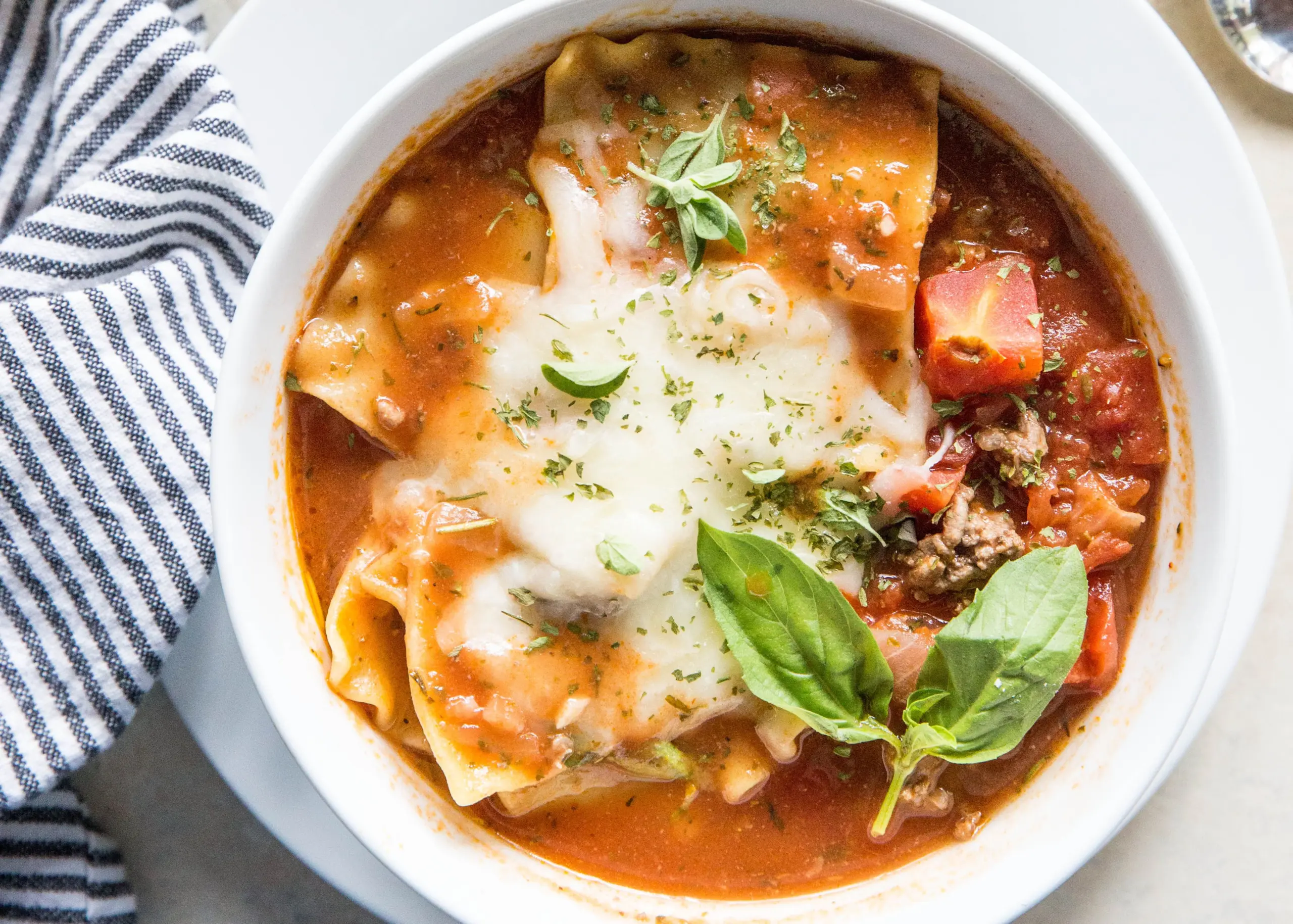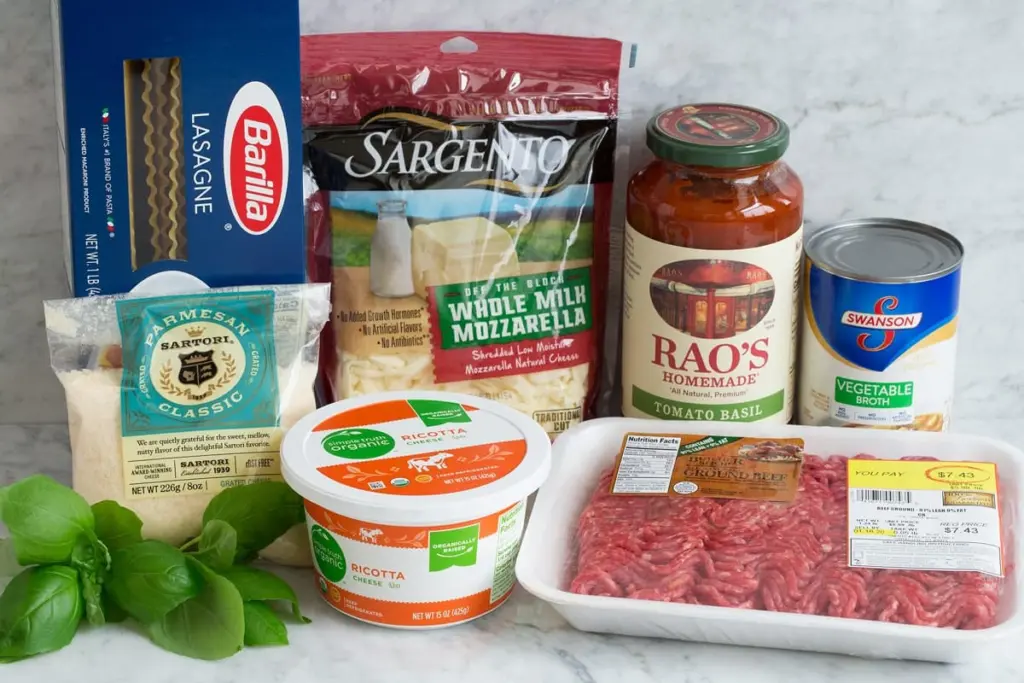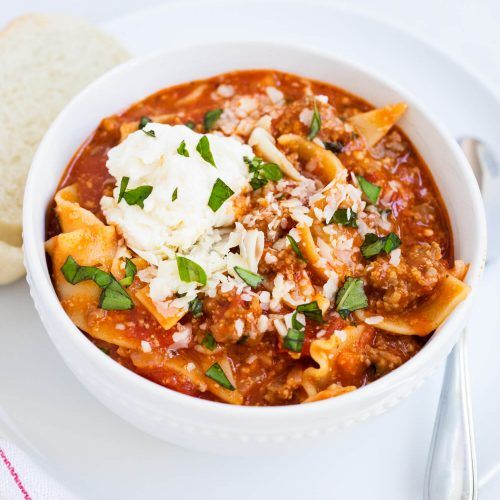
Experience the warmth and richness of lasagna transformed into a cozy, comforting soup with our detailed guide to making the ultimate Lasagna Soup. This dish not only provides the heartwarming flavors of traditional lasagna but does so in a convenient, spoon-friendly format perfect for any chilly evening.
Table of contents
Why Lasagna Soup Should Be Your Next Kitchen Adventure
Overview of Lasagna Soup
Lasagna soup captures the essence of the traditional lasagna casserole in a more casual, soup form. Imagine all the rich, cheesy goodness of lasagna but in a spoon-ready broth that’s both comforting and surprisingly easy to whip up on a busy weeknight. This dish blends the robust flavors of tomatoes, ground meat, herbs, and creamy cheeses, all simmered together to create a hearty meal that feels like a hug in a bowl.
Why It’s a Popular Variant of Traditional Lasagna
You might wonder why mess with a classic? Well, lasagna soup offers a playful twist on the familiar layered pasta, while maintaining the beloved flavors. It’s a hit for several reasons:
- Effortless Preparation: Gone are the days of meticulous layering. This soup lets you toss everything into one pot, reducing kitchen mess and preparation stress.
- Nutritional Punch: With abundant options for veggies and lean proteins, lasagna soup can be a healthier alternative that doesn’t skimp on taste.
- A Dish for All Seasons: Whether it’s a chilly winter evening or a breezy summer night, lasagna soup can be tailored to suit the temperature and your mood.
Ingredients for a Perfect Batch
Before diving into the cooking process, ensure you have all the necessary ingredients to create this delectable soup:
- Meats: 1/2 pound of lean ground beef and 1/2 pound of Italian sausage enhance the robust flavors.
- Vegetables: A yellow onion and fresh spinach leaves bring freshness and nutrition.
- Flavor Enhancers: Minced garlic, tomato paste, and a rich marinara sauce build a deep, savory base.
- Cheeses: Ricotta, mozzarella, and Parmesan meld together for a creamy, cheesy finish.
- Seasonings: Fresh or dried basil, oregano, parsley, and red pepper flakes add classic Italian zest.
- Broth: Low-sodium chicken or vegetable broth provides the perfect liquid component.
- Pasta: Lasagna noodles, broken into pieces, introduce a delightful texture.
- Garnish: Fresh basil leaves for a fragrant touch.

Cooking Steps to an Irresistible Lasagna Soup
Brown the Meat
Start by cooking the ground beef and sausage in a large pot over medium-high heat until browned. Season with salt and pepper to taste. Drain the excess grease and set the meat aside.
Sauté Vegetables
In the same pot, heat olive oil over medium heat and sauté the chopped onion until soft and translucent, about 5 minutes. Add minced garlic and continue to cook for another minute or two, stirring frequently to prevent burning.
Combine Flavors
Stir in tomato paste, your choice of homemade or store-bought marinara sauce, the prepared meat, and all the spices. Pour in the broth and bring the mixture to a boil.
Pasta and Final Touches
Add broken lasagna noodles to the boiling soup, then reduce heat to medium-low. Simmer until the noodles are tender. If desired, stir in fresh spinach during the last few minutes of cooking to add color and nutrition.
Cheese Mixture
In a separate bowl, mix together the ricotta, mozzarella, and Parmesan cheeses. This blend will be dolloped on top of the soup before serving to add a creamy, delicious topping.
Serve and Enjoy
Ladle the hot soup into bowls. Add a generous scoop of the cheese mixture to each serving and garnish with fresh basil. The soup is now ready to delight your palate.

Storage and Make-Ahead Tips
Refrigeration: Store the Lasagna Soup covered in the refrigerator for 3-4 days.
Freezing: For longer storage, freeze the soup without the cheese mixture in a freezer-safe container for up to 2-3 months. Thaw overnight in the refrigerator and reheat gently on the stove. Prepare the noodles fresh if serving from frozen to ensure the best texture.
Variations to Suit Every Diet
Vegetarian and Vegan Options
For a vegetarian version, omit the meats and add a variety of vegetables such as zucchini, mushrooms, and yellow squash in the sauté step. Vegans can substitute the cheese with a homemade cashew ricotta and ensure the broth is vegetable-based.
Pasta Substitutions
Swap the lasagna noodles with any pasta of your choice, adjusting cooking times as needed to ensure the perfect texture.
Nutritional Spotlight
Health Benefits
Lasagna soup can be a balanced meal with the right ingredients. Lean meats or plant-based alternatives provide protein, while tomatoes and other veggies deliver vitamins and antioxidants.
Dietary Considerations
- Gluten-Free: Swap traditional noodles for gluten-free options.
- Low-Carb: Use zucchini ribbons instead of pasta for a lighter version.
Serving Up Comfort
Best Practices for Serving
- Accompaniments: A side of crusty bread or a crisp salad complements the soup wonderfully.
- Serving Temperature: Best served hot, ideally with the cheese freshly melted.
Lasagna Soup offers all the flavors of traditional lasagna in a comforting, slurp-worthy format. It’s perfect for a hearty meal that satisfies cravings for something warm and rich, easily customizable to accommodate any dietary needs. Enjoy crafting this delightful dish that promises to keep you cozy through the coldest days.
FAQs
Where did lasagna soup originate?
Lasagna soup originated from Italy, specifically from the 18th-century Italian city. While traditional lasagna is a layered pasta dish, lasagna soup transforms its flavors into a comforting soup, incorporating similar ingredients such as pasta, tomato sauce, cheese, and Italian seasonings .
How many calories is lasagna soup?
The calorie content of lasagna soup can vary depending on its ingredients and serving size. On average, one cup of lasagna soup contains around 302 calories .
How do you reheat lasagna soup?
To reheat lasagna soup, follow these steps:
1. Transfer the desired portion of soup to a microwave-safe bowl or a saucepan.
2. If the soup is too thick, you can add a splash of water or broth to thin it out.
3. Heat the soup in the microwave in 30-second intervals, stirring between each interval, until it reaches the desired temperature.
4. If using a saucepan, heat the soup over medium heat, stirring occasionally, until heated through.
5. Once heated, serve the lasagna soup hot and enjoy.
What not to do when making lasagna?
When making lasagna, avoid the following mistakes:
1. Using overcooked or undercooked noodles, as they can affect the texture of the dish.
2. Adding too much sauce, which can result in a watery lasagna.
3. Skipping the layering process, as layering ingredients evenly helps distribute flavors throughout the dish.
4. Using too much cheese, which can overpower the other ingredients.
5. Cutting the lasagna immediately after removing it from the oven, as it needs time to set and hold its shape.
Why does reheated lasagna taste better?
Reheated lasagna often tastes better because the flavors have had time to meld together, resulting in a more developed and flavorful dish. Additionally, the reheating process allows the ingredients to become more tender, enhancing the overall texture and taste of the lasagna .
Can you reheat soup with pasta in it?
Yes, you can reheat soup with pasta in it. However, when reheating, be mindful of the pasta’s texture, as overcooking can make it mushy. To prevent this, it’s best to reheat the soup gently over low to medium heat, stirring occasionally, until the pasta is heated through. Alternatively, you can reheat individual servings in the microwave in short intervals, stirring between each interval to ensure even heating .





